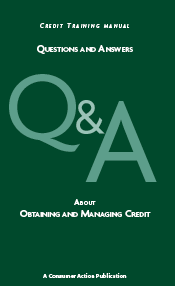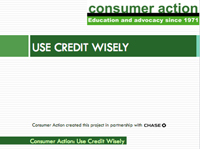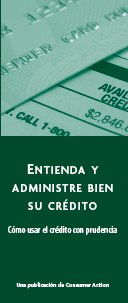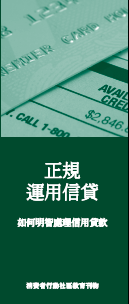Short Term Credit
Credit can be a valuable financial tool for consumers who understand its costs and benefits and how to use it wisely. This module helps consumer to defines open-ended, or revolving, credit, including credit cards, home equity lines of credit and overdraft lines of credit, and discusses the pros and cons of using credit. It includes tips on high-cost credit to avoid.
Publication List
Staying on Track With Credit
Credit can be a valuable financial tool for consumers who understand its costs and benefits and how to use it wisely. This brochure defines open-ended, or revolving, credit, including credit cards, home equity lines of credit and overdraft lines of credit, and discusses the pros and cons of using credit. It includes tips on high-cost credit to avoid.
Staying on Track with Credit - Lesson Plan
This packet provides guidance for teachers and team leaders. The 23-page packet contains a detailed curriculum, classroom activities and take home worksheets. (Note: It is only available as a PDF file.)
Staying on Track With Credit (Spanish)
El crédito puede ser una herramienta muy útil para aquellos consumidores que entienden los costos, beneficios, y la mejor manera de utilizarlo. Este folleto define los varios tipos de crédito, como el crédito abierto, que incluye las tarjetas de crédito, líneas de crédito como la protección contra sobregiros en su cuenta de cheques y líneas de crédito sobre el valor líquido de la vivienda. También explica las ventajas y desventajas de pagar a crédito y ofrece consejos sobre cómo evitar el crédito de alto costo.
Staying on Track With Credit (Chinese)
對那些瞭解信貸的使用代價跟優點,以及懂得如何明智地使用信貸的消費者來說,信貸可以成為一種有用的財務工具。這本手冊解釋了「無限次」,又稱為循還式信貸,包括信用卡,房屋淨值信貸(HELOC: Home Equity Line of Credit)和支票透支信用額(Overdraft Lines of Credit),同時還討論使用信貸的好處及壞處。該手冊還包括如何避免使用高收費信貸的技巧。
Staying on Track With Credit (Korean)
크레딧의 장단점을 잘 이해하고 크레딧을 현명하게 사용하는 소비자에게 크레딧은 재정 관리를 위한 유용한 도구입니다. 이 소책자는 크레딧 카드, 홈 에퀴티 라인 오브 크레딧과 오버드레프트 라인 오브 크레딧을 포함한 오픈 엔디드 크레딧과 리볼빙 크레딧에 대한 설명과 크레딧 사용의 장단점에 대한 설명을 포함하고 있습니다. 또한 높은 비용의 크레딧을 피하는 요령을 포함하고 있습니다.
Staying on Track With Credit (Vietnamese)
Tín dụng có thể là một công cụ tài chính có giá trị cho người tiêu dùng người am hiểu về các chi phí và lợi ích, và làm thế nào để sử dụng tín dụng một cách khôn ngoan. Bản tài liệu này định rỏ các loại tín dụng không kết thúc, hoặc tín dụng luân lưu, bao gồm cả thẻ tín dụng, tín dụng thế chân giá trị căn nhà và tín dụng bảo đảm ngân phiếu không bảo chứng, và thảo luận về những điều tốt xấu trong cách sử dụng thẻ tín dụng. Tài liệu cũng bao gồm các lời mách về những tín dụng có tổn phí cao để tránh.











